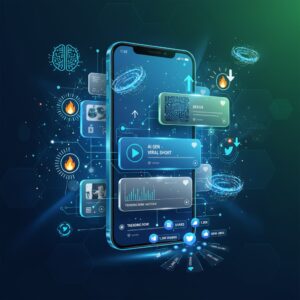
I’ve been running small businesses for over two decades, and I can tell you that writing website copy used to be one of my biggest headaches. You either paid thousands to a copywriter or spent countless hours trying to sound professional while selling your services. Now AI has changed everything.
Last month, I helped a local plumbing business rewrite their entire website using AI tools. Their conversion rate jumped from 2% to 7% in three weeks. The owner called me amazed that simple changes in how he presented his services made such a difference.
Let me show you how to use AI to create website copy that actually converts visitors into customers.
Why Most Small Business Websites Fail to Convert
Your website exists for one reason: to turn visitors into paying customers. Yet most small business websites read like boring brochures that nobody wants to finish.
I’ve reviewed hundreds of small business websites. They all make the same mistakes. They talk about themselves instead of solving customer problems. They use industry jargon that confuses people. They bury their value proposition under generic statements about quality and service.
Your potential customers land on your site with specific problems. They need answers fast. If your copy doesn’t speak directly to their pain points within seconds, they leave.
Think about the last time you needed a service urgently. Did you read through long paragraphs about company history? No. You looked for proof they could solve your problem quickly.
AI tools can analyze thousands of high-converting websites and identify patterns that work. They understand what language resonates with different audiences. They can test multiple versions of your message faster than any human copywriter.
But here’s what most people get wrong. They ask AI to write copy and paste it directly to their website. That’s like asking someone who has never met your customers to speak for your business. It doesn’t work.
How to Use AI for Website Copy That Converts
I use a specific process when helping businesses generate their website copy. This method combines AI capabilities with your real business knowledge.
Start by feeding the AI information about your actual customers. Don’t give it generic descriptions. Tell it about the last five customers who bought from you. What problems did they have? What words did they use to describe those problems? What made them choose you over competitors?
I worked with a cleaning service last year. The owner thought customers wanted spotless homes. Wrong. After talking to actual customers, we learned they wanted their weekends back. They felt guilty about messy houses but hated spending Saturday cleaning. That insight changed everything.
Give your AI tool these real customer stories. Ask it to identify pain points and desired outcomes. You’ll get copy that speaks to real people instead of imaginary ideal customers.
Next, provide AI with your unique selling points. But not the ones you think matter. The ones your customers actually care about.
A accounting firm I advised thought their 30 years of experience mattered most. Their customers cared more about same-day responses to urgent questions. We rewrote their homepage around responsiveness instead of experience. Inquiries doubled.
Ask AI to generate multiple headline options based on these real differentiators. Generate at least 20 options. Pick the three that sound most like something your customer would say to a friend.
Now comes the crucial part. Take those AI-generated headlines and test them with real customers. Send them in emails. Post them on social media. See which ones get responses.
I never publish AI-generated copy without testing it first. Last month, I generated five different versions of a product description for a furniture maker. The version I thought would win came in fourth. The winner used simpler language and focused on delivery speed instead of craftsmanship.
Use AI to write your body copy after you nail the headlines. Give it your winning headlines and ask for 3 to 5 paragraphs that expand on the main benefit. Tell it to use short sentences. Instruct it to include specific examples.
Here’s a tip that saves hours. Ask AI to write in different tones and compare them. Generate one version in a professional tone. Another in a friendly tone. A third in an urgent tone. You’ll quickly see which matches your brand and resonates with customers.
Making AI Copy Work for Your Specific Business
Every business is different. The copy that works for a law firm won’t work for a food truck. You need to customize AI outputs for your specific situation.
I run a process I call the three-filter system. Every piece of AI-generated copy goes through three filters before going live.
Filter one: Does this sound like me talking to a customer face to face? Read the copy out loud. If it sounds robotic or unnatural, edit it. Your website copy should sound like a conversation, not a legal document.
A restaurant owner I worked with had AI-generated copy that was technically perfect but completely wrong. It described their pasta as artisanal and their sauce as crafted. Their actual customers called it homemade and delicious. We changed the words. Reservations increased.
Filter two: Does this address the specific objection that stops people from buying? Every business faces objections. Too expensive. Takes too long. Might not work. Your copy must address these directly.
Ask AI to list common objections for your type of business. Then ask it to write responses to each objection. Use these responses throughout your website copy. Not in a FAQ section that nobody reads. In your main copy where it matters.
Filter three: Does this include a clear next step? Most AI-generated copy forgets to tell people what to do next. Every section of your website needs a specific action.
Don’t just say contact us. Tell them exactly what happens when they do. Schedule your free estimate and we’ll call you within 2 hours. Start your 14-day trial with no credit card required. Download the pricing guide and compare your options.
I helped a consulting firm last quarter. Their AI-generated copy was engaging but lacked clear calls to action. We added specific next steps to every page. Their consultation bookings tripled in one month.
Test everything. AI makes testing easy because it can generate variations quickly. Create two versions of your homepage. Send half your traffic to each version. Measure which one converts better. Use AI to generate new variations of the winner. Test again.
Small changes make big differences. I tested two versions of a landing page for a coaching business. The only difference was the button text. Book a call versus Schedule your strategy session. The second version converted 43% better.
You don’t need perfect copy. You need copy that converts better than what you have now. Start with one page. Use AI to generate five different versions. Test them. Pick the winner. Move to the next page.
The plumbing business I mentioned earlier? They started with just their homepage. Saw results. Then did their services page. Then their about page. Six months later, their entire website converts at 7%. Their old site converted at 2%. That difference means 150% more customers from the same traffic.
AI gives small businesses the same copywriting capabilities that Fortune 500 companies pay agencies millions for. But only if you use it correctly. Feed it real customer insights. Test everything. Edit for your voice. Focus on conversion, not creativity.
Your website copy is working 24 hours a day. It’s either converting visitors into customers or sending them to your competitors. Which one is happening on your site right now?
Please check our Business Tips https://thoughts.business/category/business-tips/
Please check our partner site – Why Invest? https://whyinvest.info/





